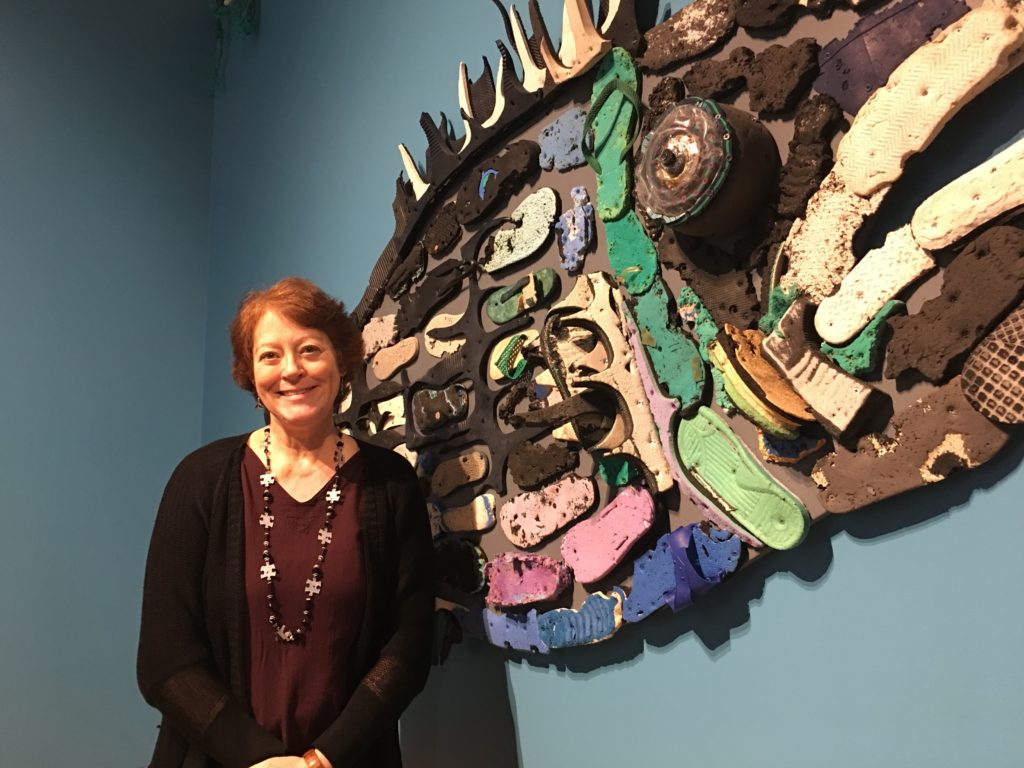
By Steve Brawner, © 2019 by Steve Brawner Communications, Inc.
June 13, 2019
Angela Haseltine Pozzi’s a-ha moment came when she was walking along her beloved southern Oregon beach and saw a “mosaic of plastic” – pieces so small she realized they were turning into sand.
“I always felt that the ocean was something that would never change, that would always be the same and be that beautiful constant, serene beautiful place. And I was horrified to know that we were really hurting the ocean so much, so I really decided that my mission in my life was going to have to be to save the ocean,” she said with a laugh.
The artist and art teacher founded Washed Ashore in 2009 at age 51. It has created 75 works of art from 22 tons of trash washed up on the Oregon coastline to call attention to ocean pollution. Pozzi has done this with help from a staff of 10 and more than 14,000 volunteers. Twenty pieces are on display at the Clinton Presidential Center in Little Rock until Oct. 27.
How big is the problem? Her website says the world produces 300 million pounds of plastic annually, and less than 10 percent is recycled. In some places overseas, trash-infested rivers are pouring plastic into the ocean. Some of the plastic litter in Arkansas’ recently flooded areas likely will end up in the sea. Plastic is not biodegradable and can take hundreds of years to disintegrate (turn into tiny plastic pieces). Sea creatures mistake it for food and eat it, so it enters the food chain. Ocean currents have created the Great Pacific Garbage Patch, which is twice the size of Texas, between California and Hawaii. There are four other garbage patches worldwide. Trash including a plastic bag has been found in the Mariana Trench seven miles below the surface.
Pozzi walked me through the art on display at the Clinton Center. Each was produced using only plastic and other trash, the only addition being screws and wire. Nothing is painted because plastic comes in all colors.
Among the creations is Eli the Eel, made with piping and an inner tube along with a tail made from a Japanese village marker that floated to Oregon after a tsunami. A bleached out “coral reef” was constructed with white styrofoam and other trash. Across from it is a multicolor “reef at risk” made from shoes, chair parts, chewing tobacco cans and many other items. One of the largest creations is Greta the Great White Shark, whose mouth and nose are composed of shotgun shells, a gas mask, a flashlight and other items.
“People always say, ‘You know, what’s the strangest thing?’ I’ve processed so much garbage that nothing’s unusual to me,” she said.
One of her pieces, “The Plastic Tribe,” features ceremonial masks made from trash. Its plaque says humans “worship” plastic.
I asked her how literally she meant that.
“Well, you know, that is a strong word, but I think that … we feel lost without it,” she said. “I feel like we are beholden to it. We are dependent on it.”
You can go online and find “zero waste” people who produce virtually no trash. Pozzi doesn’t expect that of herself or others. Instead, she reduces, reuses, refuses and recycles. (China and other countries won’t accept our trash anymore, so recycling isn’t such an automatic easy answer anymore.) She carries a water bottle with her so she doesn’t need throwaway plastic ones, the most common item that washes ashore. When offered a plastic bag at the Clinton Center, she instead asked for a paper one.
She says environmentalists often fail when they take an us vs. them approach, so she’s not anti-corporation. Corporations will be part of the solution given the profits that will come from plastic alternatives. One example that’s already coming: Kroger is phasing out plastic bags. I’ve started carrying reusable bags wherever I grocery shop. Among the upsides is fewer and better organized bags to carry to and from the car.
Plastics pollution is an undeniable problem. We can see the trash on the beach, the roadside and the parking lot. And once you’re aware of it, it’s hard to unsee. Washed Ashore is admirably educating the world about our threatened oceans. But hopefully it will soon go out of business for lack of materials, and Pozzi can make art from something else she finds at the beach.
Maybe sand. The real kind.